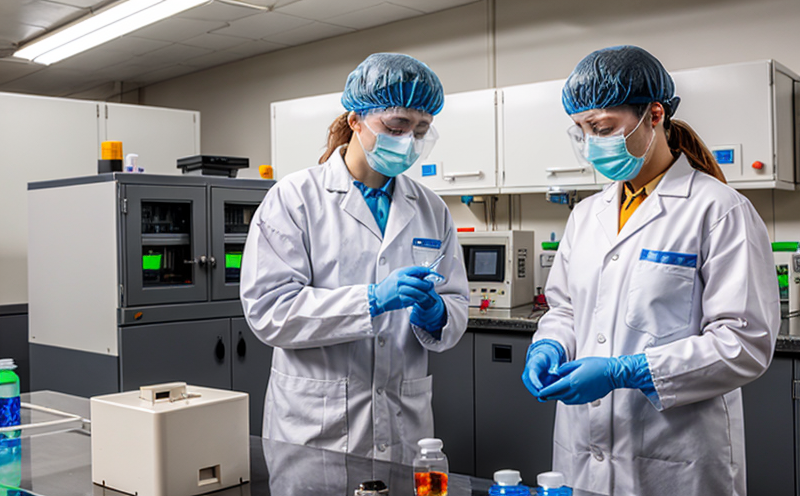ISO 26410 Hydroxymethylfurfural Analysis in Honey
The analysis of hydroxymethylfurfural (HMF) content in honey is a critical aspect of food and feed safety testing, especially when adhering to the ISO 26410 standard. HMF is a byproduct of fructose and glucose dehydration that can form during honey processing or storage under certain conditions. This analysis helps ensure that honey meets quality standards set forth by international regulations.
The process involves precise sample preparation, followed by chemical analysis using high-performance liquid chromatography (HPLC) equipped with UV detection. The aim is to quantify HMF levels accurately and reliably. Proper sample handling ensures accurate results; samples should be representative of the batch being tested and stored under controlled conditions to avoid degradation.
Compliance with ISO 26410 not only guarantees product quality but also enhances consumer trust by ensuring that processed honey adheres strictly to established limits for HMF content. This standard is particularly relevant in markets where there are stringent requirements on food additives, preservatives, and processing contaminants.
The significance of this analysis extends beyond regulatory compliance; it also plays a role in product differentiation within the market. Consumers increasingly seek products that meet high safety standards, and demonstrating adherence to ISO 26410 can be a selling point for honey producers. Additionally, accurate HMF levels are crucial for identifying potential spoilage or contamination issues early on.
Our laboratory uses state-of-the-art equipment and adheres strictly to the ISO 26410 methodology to provide reliable results. This includes rigorous quality control measures at every stage of testing to ensure accuracy and reliability. By choosing our service, you are ensuring that your honey products meet international standards and can be trusted by both consumers and regulatory bodies.
The importance of HMF analysis cannot be overstated in maintaining food safety and quality. It is a key indicator of processing conditions and potential spoilage risks. Regular monitoring through ISO 26410-compliant testing ensures that honey remains safe and high-quality, thereby protecting consumer health and enhancing brand reputation.
For those involved in the production or distribution of honey products, understanding HMF levels is essential for maintaining product integrity. This analysis not only helps meet regulatory requirements but also supports informed decision-making regarding processing methods and storage conditions to minimize unwanted chemical byproducts.
Benefits
- Ensures compliance with ISO 26410 standards, enhancing product safety and quality.
- Promotes consumer trust by demonstrating adherence to international food safety regulations.
- Aids in identifying potential spoilage or contamination issues early on.
- Differentiates products within the market based on strict quality control measures.
- Supports informed decision-making regarding processing methods and storage conditions.
Quality and Reliability Assurance
Our laboratory is committed to delivering accurate, reliable results that meet the highest standards of quality assurance. We employ experienced professionals who are well-versed in ISO 26410 methodology and adhere strictly to established protocols throughout the testing process.
We invest heavily in maintaining our equipment, ensuring it remains up-to-date with the latest technology required for precise HMF analysis. Regular calibration and validation of instruments guarantee consistent and accurate results every time. Our quality assurance team conducts thorough audits at regular intervals to ensure all processes comply with international standards.
In addition to technical expertise, we also emphasize robust sample handling practices. Representative samples are selected carefully from batches, stored under controlled conditions to prevent any degradation or alteration before analysis begins. This precautionary approach ensures that the data obtained reflects true HMF levels present in the product.
Our commitment to quality extends beyond just technical aspects; it encompasses a culture of continuous improvement and innovation within our laboratory. By staying abreast of advancements in analytical techniques and best practices, we aim to provide ever more precise and reliable results for our clients.
Use Cases and Application Examples
In-process monitoring during the manufacturing process to ensure HMF levels remain within acceptable limits.
Batch release testing prior to distribution, ensuring each batch meets ISO 26410 standards before being made available to consumers.
Post-market surveillance to detect any unexpected changes in HMF content over time which may indicate spoilage or contamination issues.
Research and development activities aimed at optimizing processing methods to minimize unwanted chemical byproducts like HMF.
The accurate measurement of HMF in honey through ISO 26410-compliant testing is crucial for maintaining product safety, quality, and consumer trust. By implementing rigorous testing protocols, manufacturers can ensure their products meet international standards while also contributing to broader food safety initiatives.





